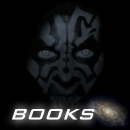



|
By Greg Bear |
Rogue Planet takes place 3 years after Star Wars, Episode I: The Phantom Menace. Anakin Skywalker is now 12 years old, apprenticed to Obi-Wan Kenobi, and showing signs of pre-teen rebellion and/or the draw of darkside influences. The bond between master and Padawan is frayed, Anakin is unable or unwilling to leave behind the emotional scars inherited from a childhood of slavery, and Obi-Wan is full of self-doubt about his ability to lead Anakin along the correct path. In an effort to give the apprenticeship some "quality" time, and as a sort of Outward Bound test of the relationship, the Jedi Council elects to send Obi-Wan and Anakin to a remote planet, Zonama Sekot, rumored to be the source of a new and wondrous ship-building technology, and also the last known destination for a Jedi Knight who disappeared while investigating strange goings-on in the Zonama Sekot region.
Once at Zonama Sekot, the puzzles and intrigues deepen; the Jedi Council are not alone in their interest in the gifts the planet may have to offer. It seems the brilliant weapons and ship designer Raith Seinar has also begun his own inquiry into the wonders leaking out of this sector of the galaxy. And Seinar too is fighting for ascendancy, trying to stay one step ahead of the ruthless plotting of machiavellian Commander Wilhuff Tarkin. The planet itself performs a role. It holds powers far greater than any of these contenders have imagined…powers that speak to Anakin in disturbing and confusing ways, and threaten to further unhinge the link between Anakin and Obi-Wan.
Rogue Planet is an excellent first connecting story between the events we already know of from The Phantom Menace, and the great unknowns of EP2. The book hosts a fascinating stand-alone plot in Obi-Wan's and Anakin's unraveling of the genuinely mysterious events and portents of Zonoma Sekot. Author Greg Bear takes his time peeling back the layers on this core storyline, so that the end revelations play out in a fairly surprising manner. At the same time, there are several interwoven sub-plots and Star Wars continuum tidbits that add a great deal of richness and resonance to the complete package. Especially satisfying was the inclusion of eventually-to-be-Moff Tarkin, shown at the early stages of his clearly manipulated rise to power, and the interesting and enigmatic ship designer Raith Seinar, who will go on to build the infamous TIE fighter, but who in these earlier years is portrayed as a conflicted pragmatic aesthete. Fascinating too, is the look we get into the inner workings of the Jedi Council. As depicted here, the Council seems to be essentially a bunch of misdirected, inconsistently stern, out-of-touch parents, whose most gifted child keeps testing their strictures, and whose lack of connection to the humdrum, non-Jedi galaxy leaves them truly doomed long before prophecies and Palpatine.
The book does have some flaws. Greg Bear uses some oddly out-of-place language….Obi-Wan contemplating that Anakin "ragged" him about something, for example…that jarringly shoves the reader out of the Star Wars universe and back to our own. Bear also hasn't the situational awareness, the ability to keep multiple balls in the air, that distinguishes the better writers such as Michael Stackpole or Timothy Zahn. Battle scenes are imprecise and rather poorly described. Too, Bear employs weird inter-cutting between story elements. Where in a Stackpole or Zahn effort the flow appears natural and seamless, there is something abrupt and forced in this book. Some segments go on too long, some cut off so suddenly it feels like the station is taking a commercial break before the scene is over, and there is a sense that Bear periodically forgets about characters or plot arcs for stretches of the narrative…then suddenly beams awkwardly back to them. Bear also falls into the alien one-upmanship trap, whereby each new author is compelled to create ever more shocking species. When it works, it makes the SW galaxy more vivid; when it's off a bit, as it sometimes is in Rogue Planet, it just comes across as self-conscious.
One other small fly in the ointment is possibly not of Greg Bear's doing. There are odd inconsistencies in the portrait of Anakin as painted in this novel. Obi-Wan constantly refers to how perplexing and worrisome Anakin is, yet he is less layered in mystery than he is simply poorly drawn. But that might be more due to the constraints of the vagaries of the movie-making process…and to the two-dimensional performance by Jake Lloyd in TPM…than to any writing weaknesses. To Bear's credit, he goes a long way toward fixing these problems. By the end of the book, Anakin's inner turmoil is much clearer, his pain and confusion much more visceral.
For all its minor deficiencies, Rogue Planet packs quite a punch. Several moments are ineffably moving; Qui-Gon Jinn's loss hovers (real or imagined?) over both Anakin's and Obi-Wan's shoulders, and Obi-Wan's sadness at missing his Master is sweetly rendered. And whether as fans the readers bring foreknowledge to the table, or whether it is the effectiveness of the writing, the goose-bump chills of Anakin's destiny and the hints of incipient evil seep out of the pages like a physical presence. Let's hope more such enjoyable efforts are in store for these "bridge" novels, to tide us over until Episode Two.
![]()
In the first of the GalaxyFarAway.com
Books Features, we have an exclusive interview with the
Black Fleet Crisis Series author, Michael
Kube-McDowell.
Read it here!
![]()
The
Darth Maul Journal

Discuss the Books in the Arena Message Boards
